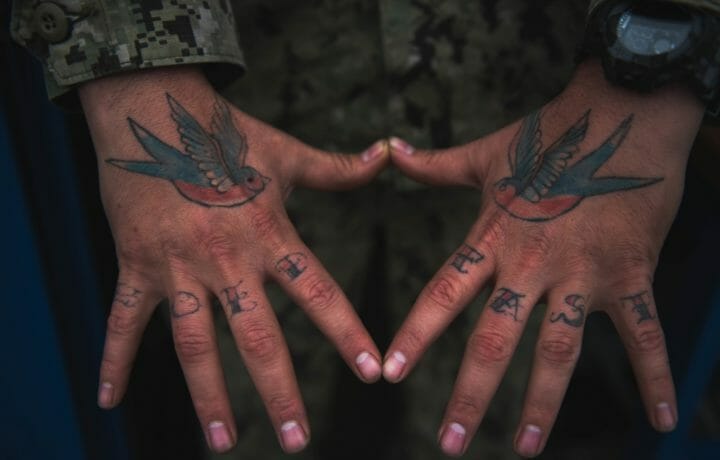Tattoos are a form of personal expression that has become widely accepted in recent years, but some of the population still believes that you can’t enter the military or even get a decent job if you’re tatted up.
Not having a tattoo nowadays could actually be deemed as going against the grain. A 2015 poll found that 26% of Gen Z have tattoos and almost half of all millennials have tattoos, compared to just 13% of baby boomers.
So, your body is a temple, but you decided to paint the walls. We’re here to debunk some of the myths surrounding tattoos and what it means for your professional career.
MILITARY TATTOOS
Some people on social media were adamant that you can’t join the military with a sleeve…NOT TRUE. Each military branch has its own policies, with most of them becoming more relaxed during the war in Afghanistan (2015) in hopes of getting more recruits.
But before you ink up and are interested in joining the U.S. armed forces, or are currently active duty, be sure to do your research or ask your unit directly.
US Army
The US Army tattoo policy was updated in 2015 but prohibits any tattoos on the head, face, neck, wrists, hands, or above the collar. Veterans are proponent of the t-shirt test. If you can still see it, just don’t do it. Basically, any visible tattoos are prohibited. They do make an exception for a ring tattoo per hand. For cosmetic tattoos (for females only), they must be conservative and leg tattoos cannot cover the knee. This branch is almost the strictest of all the branches.
US Marine Corps
Marine tattoos must be completely covered by the standard training uniform, and no tattoos may appear on the head, neck, wrists, knees, elbows, or hands. They are allowed one ring tattoo but must be under 3/8 of an inch. Visible tattoos must be smaller than the Marine’s hand and like the US Army, must end two inches above or below the elbow or knee. This branch is the strictest of all the branches.
US Navy
The Navy tattoo guidelines were updated in 2016 and allow tattoos anywhere on the body except the head, face, or scalp. The Navy is the only branch that allows tattoos on the hands.
US Air Force
The Air Force policy is similar to the US Navy’s (and updated in 2017) but excludes tattoos on the hands. Those serving in the Air Force can also have full sleeves or large pieces of artwork on their backs.
US Coast Guard
In the US Coast Guard, sleeves are permitted and like other branches, they are allowed one ring tattoo. For the t-shirt test, there is a bit of wiggle room: the policy states that tattoos on the chest cannot rise more than one inch above the v-neck under the Tropical Blue uniform. No ‘I LOVE MOM’ neck tattoos are allowed, though.
ADVICE FOR YOUR CIVILIAN CAREER
Some federal agencies do not have strict or even explicit policies on tattoos. The CIA even notes that tattoos will NOT disqualify you from gaining employment, and all professionally qualified people are encouraged to apply still. While organizations like the FBI have stricter regulations on physical appearance in regards to remaining clean and professional, they don’t specifically ban tattoos for employees.
But like the military, the general what, where, and how big questions apply. Could the content be deemed as offensive? Is it derogatory to a certain group of people? Would your mom wince at the sight of it? Ask yourselves these questions before branding yourself.
Is the tattoo covering your face? Are there distracting markings visible on your neck? These are questions that highlight what would stand out to a potential employer in an interview.
Coming from a millennial who’s covered in them, whether you agree or disagree with throwing some paint up, I’ve never had an issue obtaining employment in national security due to my ink. I love that my tattoos tell my story or what is important enough to keep on my body forever. But I can also cover mine with long sleeves during an interview. Best bet is to sit on the idea for six months to a year, and if you’re still game for sitting under a needle, go for it.




